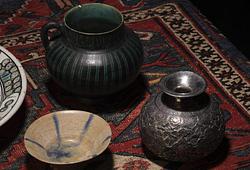A copper alloy sculpture of Bodhisattva Avalokiteshvara, possibly Western Tibet/West Himalaya 11/12th Century.
Seated on a raised lotus throne with the hands in vitarka and dyana mudras. The right knee raised and the left leg in front of the figure. A doti is swept around the bejewelled figure. Height 23,5 cm.
Wear. Tarnished.
Alkuperä - Provenienssi
The Collection of Poul Nortung (1905-1973).
The Manufacturer Poul Nortungs passion for Chinese and Japanese Works of Art started at an early age, influenced by his father, master bookbinder Frederik Nortung, who collected Oriental Ceramics, Literature and Works of Art. He himself started to expand the family collection during the years 1935-1950. Poul Nortung owned a Danish metal company known as LUXOR. The antiques in his collection were often acquired in London, Paris and Germany, or through his friend, the antique dealer Canova Skånstrom.
For other lots sold from this collection see Bukowskis Spring Auction 2013 0574 lot 1774 and onwards.
Muut tiedot
After the tenth century, one of the more prominent representations of Avalokiteshvara shows the bodhisattva seated with the right knee raised and the left leg crossed before the body. The posture represents the Water Moon manifestation, understood as a depiction of the divinity in his Pure Land, or personal paradise. Known as Mount Potalaka, Avalokiteshvara’s Pure Land was originally thought to be located on an island somewhere south of India. By the Ming dynasty (1368–1644), this mythical paradise had been identified with Mount Putuo, an island off the east coast province of Zhejiang, and had become an important pilgrimage site.















































